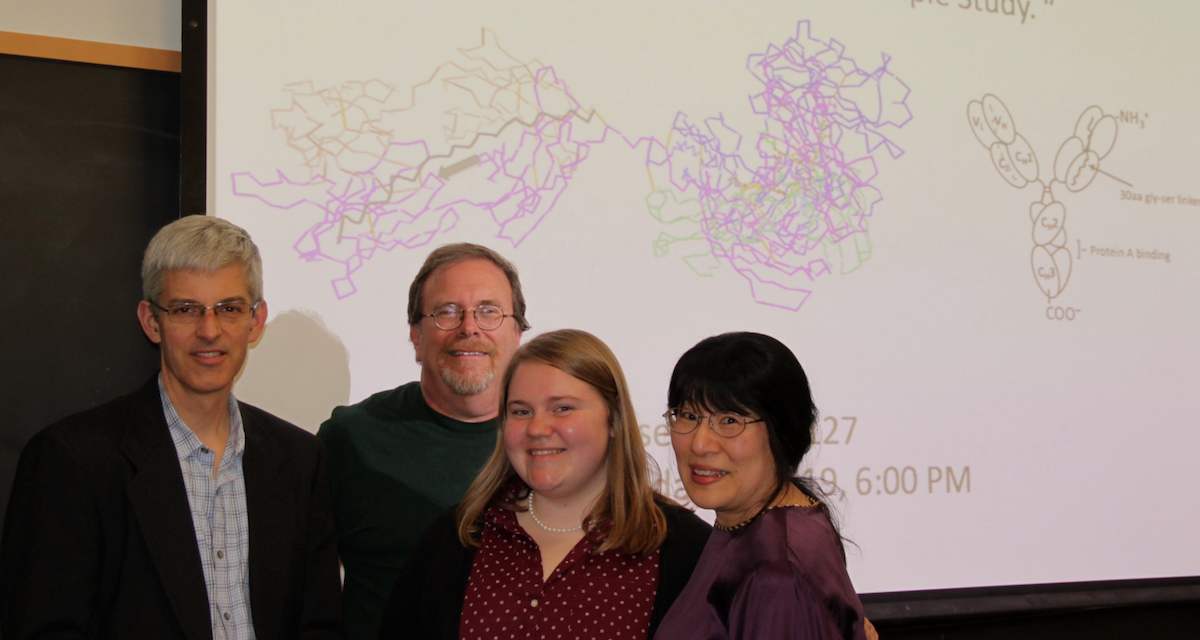Making Strides in Medical Research, One Step at a Time
Two Gordon alumni were recently recognized for their research in the labs of Duke University. Both Verna Curfman ’17 and John Yoon’s ’14 names appear in the 2017 article entitled “Thrombalexin: Use of a Cytotopic Anticoagulant to Reduce Thrombotic Microangiopathy in a Highly-Sensitized Model of Kidney Transplantation,” published by The American Society of Transplantation and the American Society of Transplant Surgeons.
Yoon works full-time in the Duke lab. He got his start as a Spanish and biology double major (pre-health professions concentration) with a chemistry minor, and applied to an internship program through Drs. Stephen Tsang and Stuart Knechtle. What started as an opportunity to work during the summer with a group at Emory University turned into a research assistant job the following year. When the group moved up to Duke University, he secured a position at Duke Transplant Center as a research technician.
Curfman (pictured above with Dr. Craig Story [biology], Prof. Irv Levy [chemistry] and Dr. Angie Cornwell [biochemistry]) was a biology student at Gordon at the time of the research. Curfman’s positive track record and previous work with and mentorship by Dr. Story earned her a lab internship at Duke.
In a collaborative effort that included Dr. Knechtle, Curfman and Yoon developed a new molecule to prevent blood clots from forming around a transplanted organ. While clotting is necessary for a wound to heal, when blood cells are sent to a transplanted organ during the healing process, the body might perceive the clotting as a “foreign” (and therefore dangerous) entity in the body. The body might then send antibodies to fight this “invader,” triggering an extreme immune response—which can be detrimental to the body receiving the new organ.
“I would take white blood cells with special fluorescent markers and mark them with a laser,” Curfman explains. “That way you can measure at a very specific level what kind of response they’re having. There’s a specific subtype of cells that, if they were to decrease, it would cause too much immune suppression.” This test could show if the protein was affecting the transplant negatively, she says. In this field, every single cell is vital to new research.
“We found that the drug Thromboxane did help prevent clotting and showed overall less clotting of the transplanted kidney,” Curfman says—a very tangible and positive finding.
As a member of Dr. Knechtle’s staff, Yoon says, “We are working to formulate regimens that may lead to ‘deleting’ the increased immunity against donors so that we can make subsequent transplants possible.”
The future of this research, Yoon says, will continue to improve the ease with which patients can receive a donated organ. Because organs are expensive and difficult to get, and a successful transplant can be the difference between life and death, this research is crucial, he says.
Curfman spent her final semester at Gordon this spring working on her senior honors thesis entitled, “Cloning and Expression of IgG Antibodies as s Single Polypeptide: A Proof-of-principle Study.” She discovered several technical issues which Dr. Story considers “a big step forward for the project.”
“Before Gordon and the Duke research, I had planned on going into family practice,” Curfman says,” but now after my lab work, I can’t imagine never doing research again.” Now she’s applying to medical school, encouraged by Dr. Story and the other connections she’s made at Duke.
Yoon plans to continue as a research technician, and then pursue studies at a clinical healthcare provider school such as medical or nursing school. Medical research, he says, is a major source of learning and experience.
“There are always a lot of new developments in biomedical cancer research and biotechnology,” Dr. Story says, considering the many opportunities on the North Shore and in Boston and Cambridge. “Fields are progressing at a rapid rate with growing understanding and technology. There’s a big horizon ahead and we’re just starting to discover and learn about new therapies.”
By Sierra Elizabeth Flach ’18, communication arts and English language and literature (creative writing)
 The Bell
The Bell